Analysis of International Expansion: Marina Bay Sands, Mumbai
VerifiedAdded on 2021/04/17
|9
|1625
|154
Report
AI Summary
This report analyzes the international expansion strategy of the Marina Bay Sands resort, focusing on its potential entry into the Indian market, specifically Mumbai. It begins with an executive summary and introduces the context of international expansion and the resort's background. The report then identifies the target market in India, highlighting the country's service sector and the growing hospitality and tourism industry. It examines economic and competitive challenges the resort may face, including competition from existing hotel chains and substitute offerings. The report recommends strategic approaches to overcome these challenges, such as extensive market research, advertising, and building a competitive edge through unique offerings like shopping experiences. Finally, the report suggests a market entry strategy involving a wholly-owned subsidiary to ensure control over the supply chain and brand value. References to relevant academic literature are included to support the analysis.
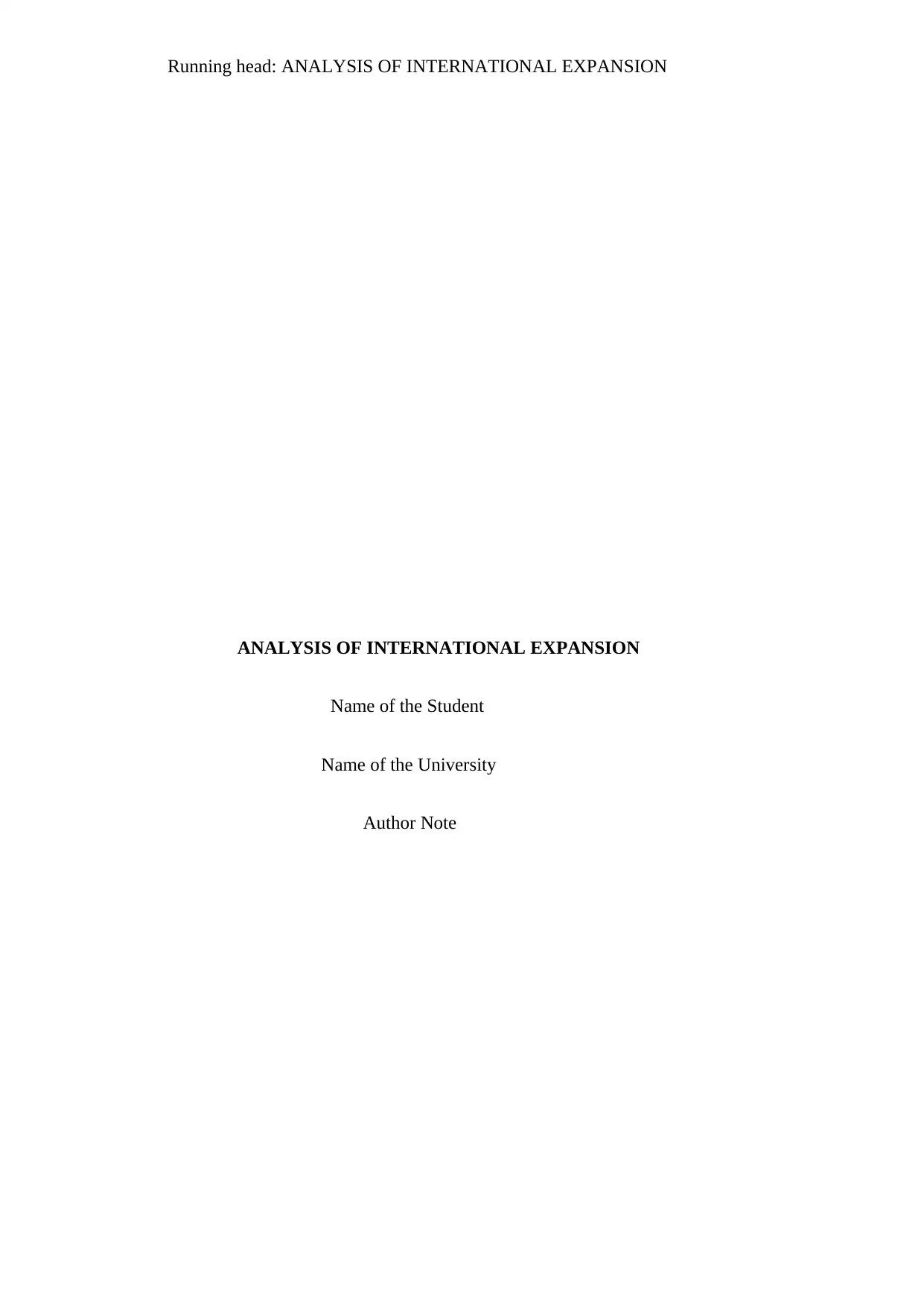
Running head: ANALYSIS OF INTERNATIONAL EXPANSION
ANALYSIS OF INTERNATIONAL EXPANSION
Name of the Student
Name of the University
Author Note
ANALYSIS OF INTERNATIONAL EXPANSION
Name of the Student
Name of the University
Author Note
Paraphrase This Document
Need a fresh take? Get an instant paraphrase of this document with our AI Paraphraser
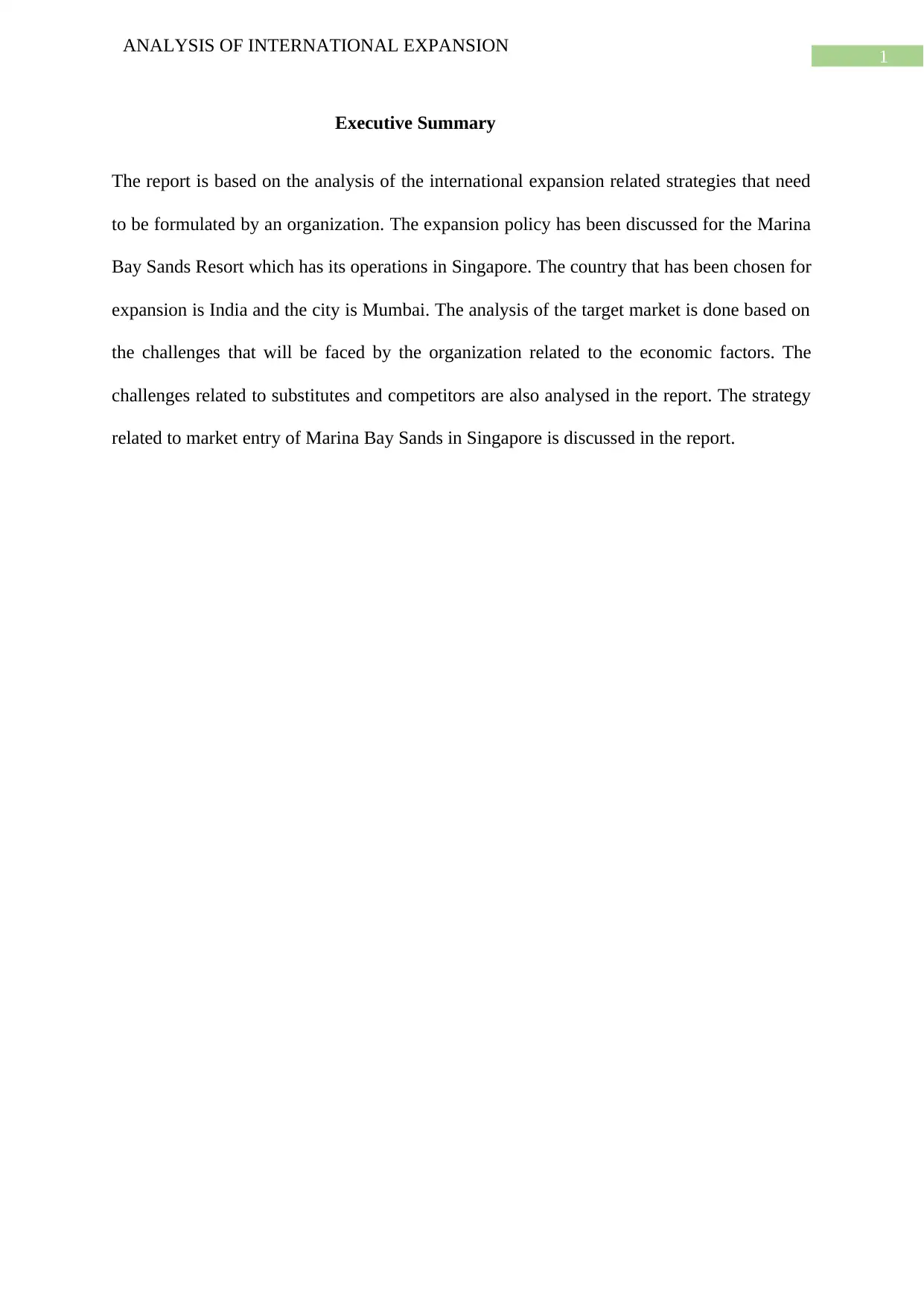
1
ANALYSIS OF INTERNATIONAL EXPANSION
Executive Summary
The report is based on the analysis of the international expansion related strategies that need
to be formulated by an organization. The expansion policy has been discussed for the Marina
Bay Sands Resort which has its operations in Singapore. The country that has been chosen for
expansion is India and the city is Mumbai. The analysis of the target market is done based on
the challenges that will be faced by the organization related to the economic factors. The
challenges related to substitutes and competitors are also analysed in the report. The strategy
related to market entry of Marina Bay Sands in Singapore is discussed in the report.
ANALYSIS OF INTERNATIONAL EXPANSION
Executive Summary
The report is based on the analysis of the international expansion related strategies that need
to be formulated by an organization. The expansion policy has been discussed for the Marina
Bay Sands Resort which has its operations in Singapore. The country that has been chosen for
expansion is India and the city is Mumbai. The analysis of the target market is done based on
the challenges that will be faced by the organization related to the economic factors. The
challenges related to substitutes and competitors are also analysed in the report. The strategy
related to market entry of Marina Bay Sands in Singapore is discussed in the report.
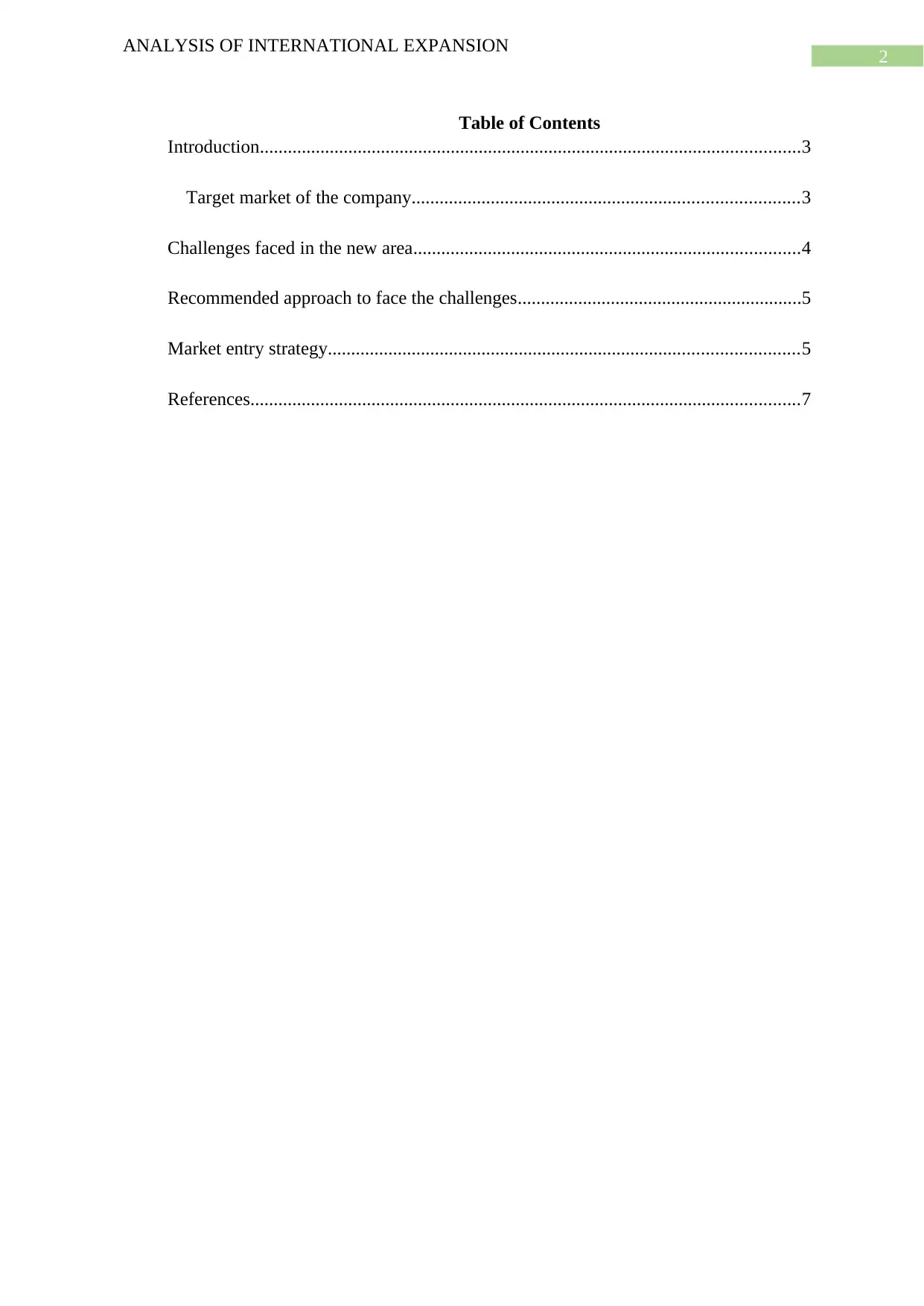
2
ANALYSIS OF INTERNATIONAL EXPANSION
Table of Contents
Introduction....................................................................................................................3
Target market of the company...................................................................................3
Challenges faced in the new area...................................................................................4
Recommended approach to face the challenges.............................................................5
Market entry strategy.....................................................................................................5
References......................................................................................................................7
ANALYSIS OF INTERNATIONAL EXPANSION
Table of Contents
Introduction....................................................................................................................3
Target market of the company...................................................................................3
Challenges faced in the new area...................................................................................4
Recommended approach to face the challenges.............................................................5
Market entry strategy.....................................................................................................5
References......................................................................................................................7
⊘ This is a preview!⊘
Do you want full access?
Subscribe today to unlock all pages.

Trusted by 1+ million students worldwide
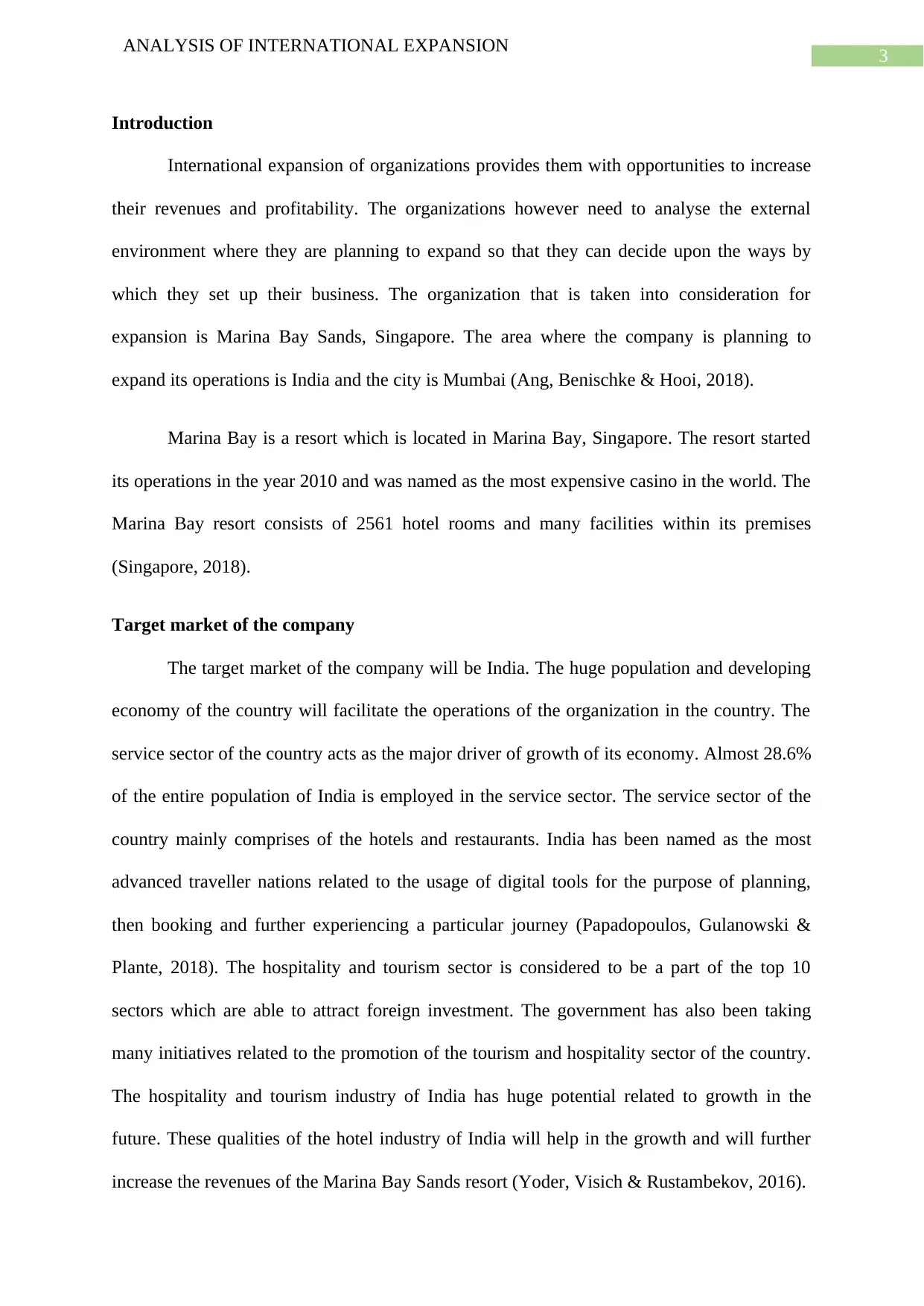
3
ANALYSIS OF INTERNATIONAL EXPANSION
Introduction
International expansion of organizations provides them with opportunities to increase
their revenues and profitability. The organizations however need to analyse the external
environment where they are planning to expand so that they can decide upon the ways by
which they set up their business. The organization that is taken into consideration for
expansion is Marina Bay Sands, Singapore. The area where the company is planning to
expand its operations is India and the city is Mumbai (Ang, Benischke & Hooi, 2018).
Marina Bay is a resort which is located in Marina Bay, Singapore. The resort started
its operations in the year 2010 and was named as the most expensive casino in the world. The
Marina Bay resort consists of 2561 hotel rooms and many facilities within its premises
(Singapore, 2018).
Target market of the company
The target market of the company will be India. The huge population and developing
economy of the country will facilitate the operations of the organization in the country. The
service sector of the country acts as the major driver of growth of its economy. Almost 28.6%
of the entire population of India is employed in the service sector. The service sector of the
country mainly comprises of the hotels and restaurants. India has been named as the most
advanced traveller nations related to the usage of digital tools for the purpose of planning,
then booking and further experiencing a particular journey (Papadopoulos, Gulanowski &
Plante, 2018). The hospitality and tourism sector is considered to be a part of the top 10
sectors which are able to attract foreign investment. The government has also been taking
many initiatives related to the promotion of the tourism and hospitality sector of the country.
The hospitality and tourism industry of India has huge potential related to growth in the
future. These qualities of the hotel industry of India will help in the growth and will further
increase the revenues of the Marina Bay Sands resort (Yoder, Visich & Rustambekov, 2016).
ANALYSIS OF INTERNATIONAL EXPANSION
Introduction
International expansion of organizations provides them with opportunities to increase
their revenues and profitability. The organizations however need to analyse the external
environment where they are planning to expand so that they can decide upon the ways by
which they set up their business. The organization that is taken into consideration for
expansion is Marina Bay Sands, Singapore. The area where the company is planning to
expand its operations is India and the city is Mumbai (Ang, Benischke & Hooi, 2018).
Marina Bay is a resort which is located in Marina Bay, Singapore. The resort started
its operations in the year 2010 and was named as the most expensive casino in the world. The
Marina Bay resort consists of 2561 hotel rooms and many facilities within its premises
(Singapore, 2018).
Target market of the company
The target market of the company will be India. The huge population and developing
economy of the country will facilitate the operations of the organization in the country. The
service sector of the country acts as the major driver of growth of its economy. Almost 28.6%
of the entire population of India is employed in the service sector. The service sector of the
country mainly comprises of the hotels and restaurants. India has been named as the most
advanced traveller nations related to the usage of digital tools for the purpose of planning,
then booking and further experiencing a particular journey (Papadopoulos, Gulanowski &
Plante, 2018). The hospitality and tourism sector is considered to be a part of the top 10
sectors which are able to attract foreign investment. The government has also been taking
many initiatives related to the promotion of the tourism and hospitality sector of the country.
The hospitality and tourism industry of India has huge potential related to growth in the
future. These qualities of the hotel industry of India will help in the growth and will further
increase the revenues of the Marina Bay Sands resort (Yoder, Visich & Rustambekov, 2016).
Paraphrase This Document
Need a fresh take? Get an instant paraphrase of this document with our AI Paraphraser
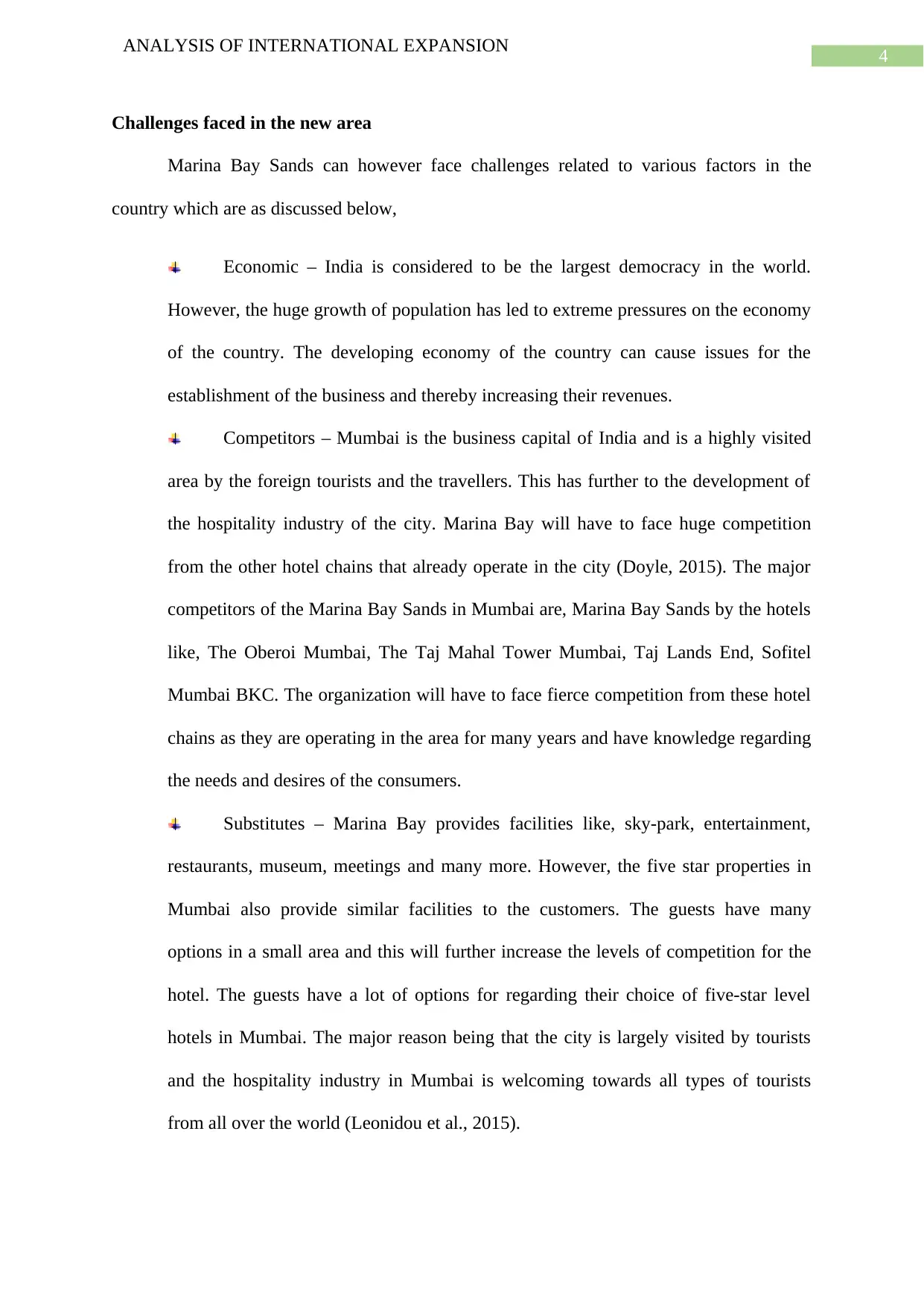
4
ANALYSIS OF INTERNATIONAL EXPANSION
Challenges faced in the new area
Marina Bay Sands can however face challenges related to various factors in the
country which are as discussed below,
Economic – India is considered to be the largest democracy in the world.
However, the huge growth of population has led to extreme pressures on the economy
of the country. The developing economy of the country can cause issues for the
establishment of the business and thereby increasing their revenues.
Competitors – Mumbai is the business capital of India and is a highly visited
area by the foreign tourists and the travellers. This has further to the development of
the hospitality industry of the city. Marina Bay will have to face huge competition
from the other hotel chains that already operate in the city (Doyle, 2015). The major
competitors of the Marina Bay Sands in Mumbai are, Marina Bay Sands by the hotels
like, The Oberoi Mumbai, The Taj Mahal Tower Mumbai, Taj Lands End, Sofitel
Mumbai BKC. The organization will have to face fierce competition from these hotel
chains as they are operating in the area for many years and have knowledge regarding
the needs and desires of the consumers.
Substitutes – Marina Bay provides facilities like, sky-park, entertainment,
restaurants, museum, meetings and many more. However, the five star properties in
Mumbai also provide similar facilities to the customers. The guests have many
options in a small area and this will further increase the levels of competition for the
hotel. The guests have a lot of options for regarding their choice of five-star level
hotels in Mumbai. The major reason being that the city is largely visited by tourists
and the hospitality industry in Mumbai is welcoming towards all types of tourists
from all over the world (Leonidou et al., 2015).
ANALYSIS OF INTERNATIONAL EXPANSION
Challenges faced in the new area
Marina Bay Sands can however face challenges related to various factors in the
country which are as discussed below,
Economic – India is considered to be the largest democracy in the world.
However, the huge growth of population has led to extreme pressures on the economy
of the country. The developing economy of the country can cause issues for the
establishment of the business and thereby increasing their revenues.
Competitors – Mumbai is the business capital of India and is a highly visited
area by the foreign tourists and the travellers. This has further to the development of
the hospitality industry of the city. Marina Bay will have to face huge competition
from the other hotel chains that already operate in the city (Doyle, 2015). The major
competitors of the Marina Bay Sands in Mumbai are, Marina Bay Sands by the hotels
like, The Oberoi Mumbai, The Taj Mahal Tower Mumbai, Taj Lands End, Sofitel
Mumbai BKC. The organization will have to face fierce competition from these hotel
chains as they are operating in the area for many years and have knowledge regarding
the needs and desires of the consumers.
Substitutes – Marina Bay provides facilities like, sky-park, entertainment,
restaurants, museum, meetings and many more. However, the five star properties in
Mumbai also provide similar facilities to the customers. The guests have many
options in a small area and this will further increase the levels of competition for the
hotel. The guests have a lot of options for regarding their choice of five-star level
hotels in Mumbai. The major reason being that the city is largely visited by tourists
and the hospitality industry in Mumbai is welcoming towards all types of tourists
from all over the world (Leonidou et al., 2015).
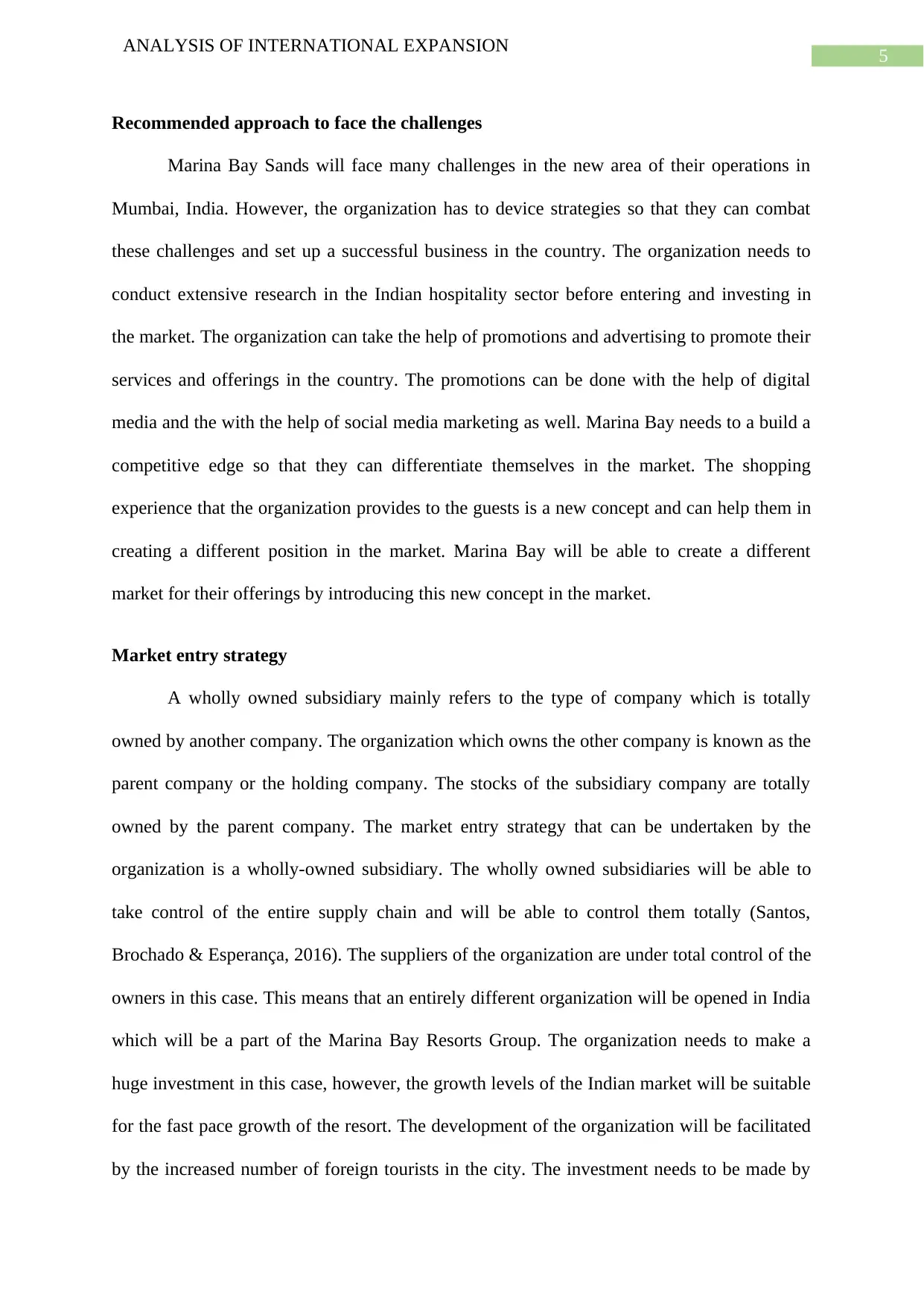
5
ANALYSIS OF INTERNATIONAL EXPANSION
Recommended approach to face the challenges
Marina Bay Sands will face many challenges in the new area of their operations in
Mumbai, India. However, the organization has to device strategies so that they can combat
these challenges and set up a successful business in the country. The organization needs to
conduct extensive research in the Indian hospitality sector before entering and investing in
the market. The organization can take the help of promotions and advertising to promote their
services and offerings in the country. The promotions can be done with the help of digital
media and the with the help of social media marketing as well. Marina Bay needs to a build a
competitive edge so that they can differentiate themselves in the market. The shopping
experience that the organization provides to the guests is a new concept and can help them in
creating a different position in the market. Marina Bay will be able to create a different
market for their offerings by introducing this new concept in the market.
Market entry strategy
A wholly owned subsidiary mainly refers to the type of company which is totally
owned by another company. The organization which owns the other company is known as the
parent company or the holding company. The stocks of the subsidiary company are totally
owned by the parent company. The market entry strategy that can be undertaken by the
organization is a wholly-owned subsidiary. The wholly owned subsidiaries will be able to
take control of the entire supply chain and will be able to control them totally (Santos,
Brochado & Esperança, 2016). The suppliers of the organization are under total control of the
owners in this case. This means that an entirely different organization will be opened in India
which will be a part of the Marina Bay Resorts Group. The organization needs to make a
huge investment in this case, however, the growth levels of the Indian market will be suitable
for the fast pace growth of the resort. The development of the organization will be facilitated
by the increased number of foreign tourists in the city. The investment needs to be made by
ANALYSIS OF INTERNATIONAL EXPANSION
Recommended approach to face the challenges
Marina Bay Sands will face many challenges in the new area of their operations in
Mumbai, India. However, the organization has to device strategies so that they can combat
these challenges and set up a successful business in the country. The organization needs to
conduct extensive research in the Indian hospitality sector before entering and investing in
the market. The organization can take the help of promotions and advertising to promote their
services and offerings in the country. The promotions can be done with the help of digital
media and the with the help of social media marketing as well. Marina Bay needs to a build a
competitive edge so that they can differentiate themselves in the market. The shopping
experience that the organization provides to the guests is a new concept and can help them in
creating a different position in the market. Marina Bay will be able to create a different
market for their offerings by introducing this new concept in the market.
Market entry strategy
A wholly owned subsidiary mainly refers to the type of company which is totally
owned by another company. The organization which owns the other company is known as the
parent company or the holding company. The stocks of the subsidiary company are totally
owned by the parent company. The market entry strategy that can be undertaken by the
organization is a wholly-owned subsidiary. The wholly owned subsidiaries will be able to
take control of the entire supply chain and will be able to control them totally (Santos,
Brochado & Esperança, 2016). The suppliers of the organization are under total control of the
owners in this case. This means that an entirely different organization will be opened in India
which will be a part of the Marina Bay Resorts Group. The organization needs to make a
huge investment in this case, however, the growth levels of the Indian market will be suitable
for the fast pace growth of the resort. The development of the organization will be facilitated
by the increased number of foreign tourists in the city. The investment needs to be made by
⊘ This is a preview!⊘
Do you want full access?
Subscribe today to unlock all pages.

Trusted by 1+ million students worldwide
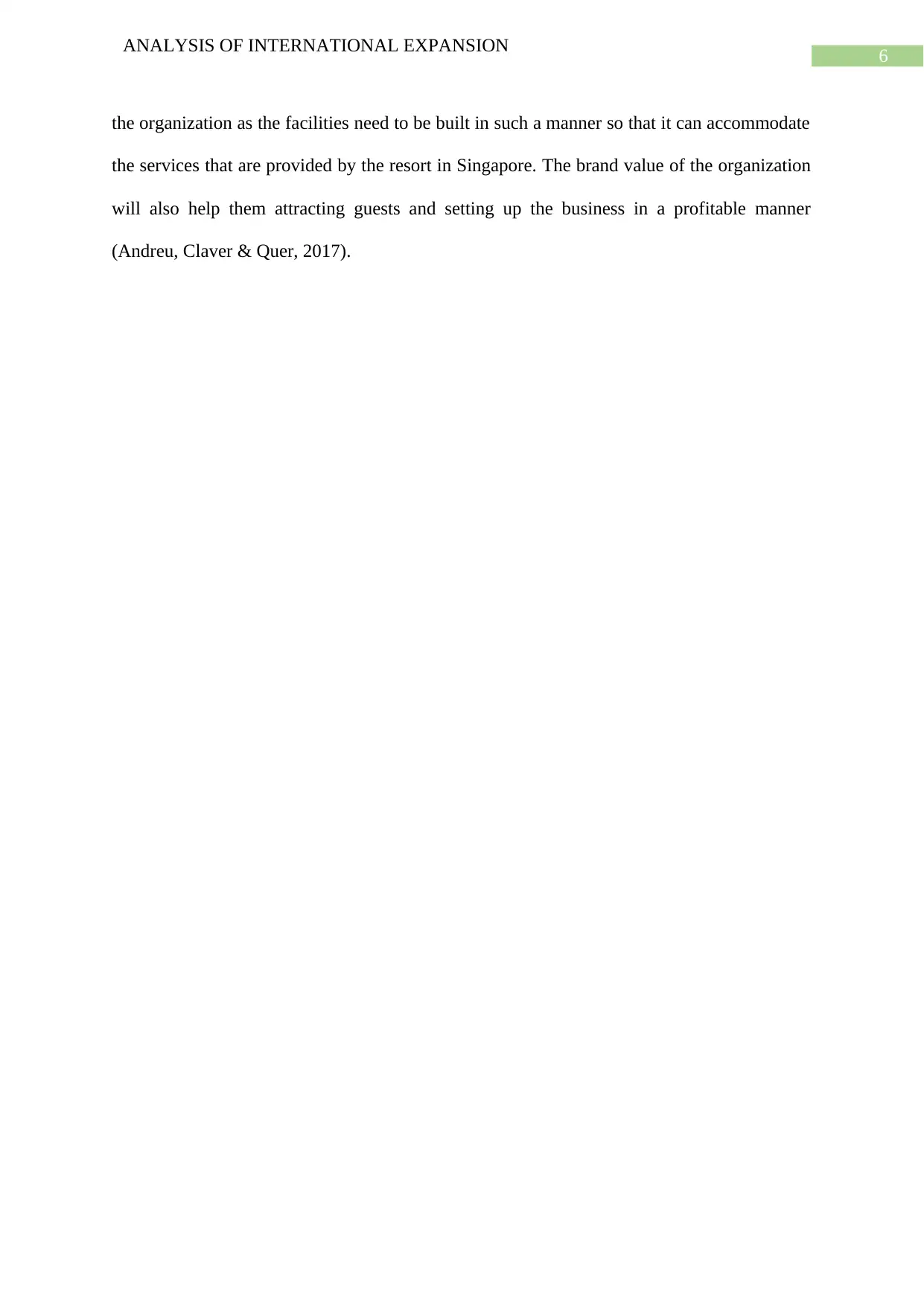
6
ANALYSIS OF INTERNATIONAL EXPANSION
the organization as the facilities need to be built in such a manner so that it can accommodate
the services that are provided by the resort in Singapore. The brand value of the organization
will also help them attracting guests and setting up the business in a profitable manner
(Andreu, Claver & Quer, 2017).
ANALYSIS OF INTERNATIONAL EXPANSION
the organization as the facilities need to be built in such a manner so that it can accommodate
the services that are provided by the resort in Singapore. The brand value of the organization
will also help them attracting guests and setting up the business in a profitable manner
(Andreu, Claver & Quer, 2017).
Paraphrase This Document
Need a fresh take? Get an instant paraphrase of this document with our AI Paraphraser
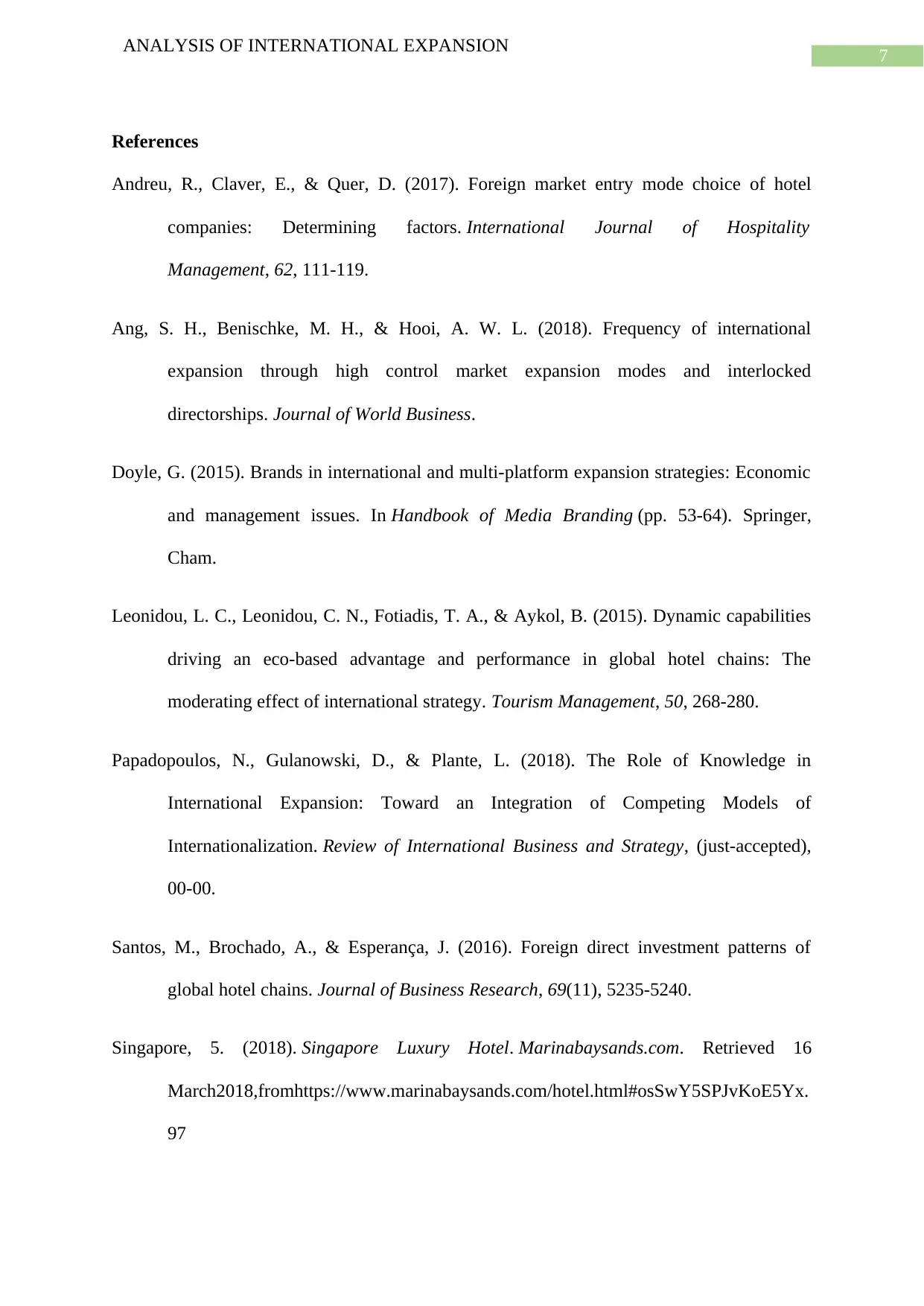
7
ANALYSIS OF INTERNATIONAL EXPANSION
References
Andreu, R., Claver, E., & Quer, D. (2017). Foreign market entry mode choice of hotel
companies: Determining factors. International Journal of Hospitality
Management, 62, 111-119.
Ang, S. H., Benischke, M. H., & Hooi, A. W. L. (2018). Frequency of international
expansion through high control market expansion modes and interlocked
directorships. Journal of World Business.
Doyle, G. (2015). Brands in international and multi-platform expansion strategies: Economic
and management issues. In Handbook of Media Branding (pp. 53-64). Springer,
Cham.
Leonidou, L. C., Leonidou, C. N., Fotiadis, T. A., & Aykol, B. (2015). Dynamic capabilities
driving an eco-based advantage and performance in global hotel chains: The
moderating effect of international strategy. Tourism Management, 50, 268-280.
Papadopoulos, N., Gulanowski, D., & Plante, L. (2018). The Role of Knowledge in
International Expansion: Toward an Integration of Competing Models of
Internationalization. Review of International Business and Strategy, (just-accepted),
00-00.
Santos, M., Brochado, A., & Esperança, J. (2016). Foreign direct investment patterns of
global hotel chains. Journal of Business Research, 69(11), 5235-5240.
Singapore, 5. (2018). Singapore Luxury Hotel. Marinabaysands.com. Retrieved 16
March2018,fromhttps://www.marinabaysands.com/hotel.html#osSwY5SPJvKoE5Yx.
97
ANALYSIS OF INTERNATIONAL EXPANSION
References
Andreu, R., Claver, E., & Quer, D. (2017). Foreign market entry mode choice of hotel
companies: Determining factors. International Journal of Hospitality
Management, 62, 111-119.
Ang, S. H., Benischke, M. H., & Hooi, A. W. L. (2018). Frequency of international
expansion through high control market expansion modes and interlocked
directorships. Journal of World Business.
Doyle, G. (2015). Brands in international and multi-platform expansion strategies: Economic
and management issues. In Handbook of Media Branding (pp. 53-64). Springer,
Cham.
Leonidou, L. C., Leonidou, C. N., Fotiadis, T. A., & Aykol, B. (2015). Dynamic capabilities
driving an eco-based advantage and performance in global hotel chains: The
moderating effect of international strategy. Tourism Management, 50, 268-280.
Papadopoulos, N., Gulanowski, D., & Plante, L. (2018). The Role of Knowledge in
International Expansion: Toward an Integration of Competing Models of
Internationalization. Review of International Business and Strategy, (just-accepted),
00-00.
Santos, M., Brochado, A., & Esperança, J. (2016). Foreign direct investment patterns of
global hotel chains. Journal of Business Research, 69(11), 5235-5240.
Singapore, 5. (2018). Singapore Luxury Hotel. Marinabaysands.com. Retrieved 16
March2018,fromhttps://www.marinabaysands.com/hotel.html#osSwY5SPJvKoE5Yx.
97
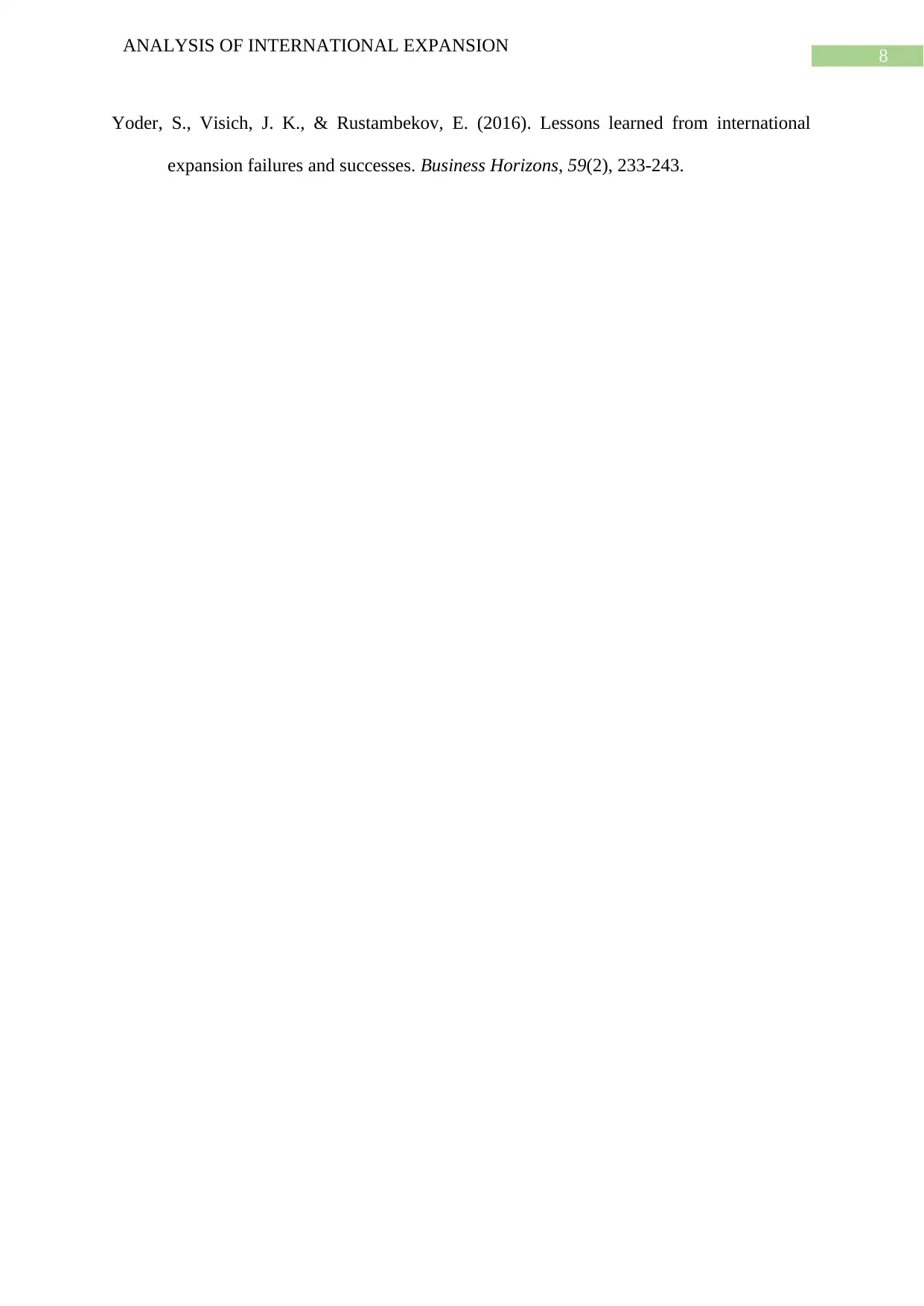
8
ANALYSIS OF INTERNATIONAL EXPANSION
Yoder, S., Visich, J. K., & Rustambekov, E. (2016). Lessons learned from international
expansion failures and successes. Business Horizons, 59(2), 233-243.
ANALYSIS OF INTERNATIONAL EXPANSION
Yoder, S., Visich, J. K., & Rustambekov, E. (2016). Lessons learned from international
expansion failures and successes. Business Horizons, 59(2), 233-243.
⊘ This is a preview!⊘
Do you want full access?
Subscribe today to unlock all pages.

Trusted by 1+ million students worldwide
1 out of 9
Related Documents
Your All-in-One AI-Powered Toolkit for Academic Success.
+13062052269
info@desklib.com
Available 24*7 on WhatsApp / Email
![[object Object]](/_next/static/media/star-bottom.7253800d.svg)
Unlock your academic potential
Copyright © 2020–2025 A2Z Services. All Rights Reserved. Developed and managed by ZUCOL.





